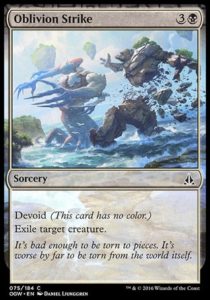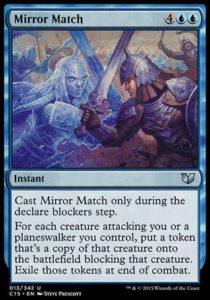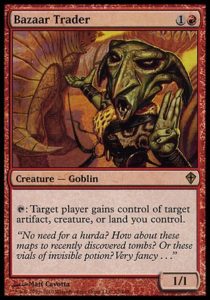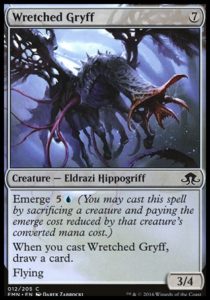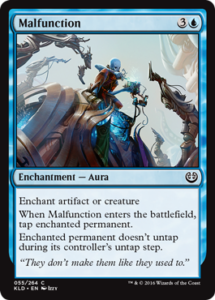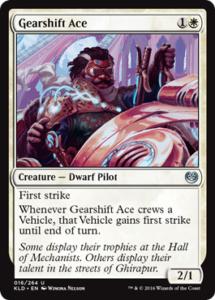Removal is one of the most important types of card. Games of Magic are decided by who can play an unanswered threat and attack for lethal. Removal spells answer threats and remove blockers impeding otherwise-lethal attacks. The power level of removal has diminished with time. Gone are the days of Lightning Bolt and Doom Blade at common, as well as four mana unconditional wraths. It’s no longer correct to just follow B.R.E.A.D. (Bombs, Removal, Evasion, Attack/Archetype, Defense) and take the best removal spell out of a bomb-less pack; some creatures are so strong that they’re more valuable than removal, and some removal spells are so weak that they’re not worth drafting early.
Modern removal tends to be context-sensitive. Every Limited format is a new context which defines a range of removal as stronger or weaker. This article is about determining that context.
Sleep Paralysis is an (essentially) unconditional four-mana removal spell (in a color generally lacking in unconditional removal) that was extremely lackluster. Oblivion Strike is also a four mana unconditional removal spell and was the best common in Oath of the Gatewatch. Why is there such a disparity in power level between these two, and what does that suggest about Malfunction?
The best way to evaluate a removal spell is a simple question with a nuanced answer: what will I use the removal spell on? The obvious answer is “whatever I need to remove,” and it’s correct. You use a removal spell on what you absolutely have to remove, either to set up a situation where you win the game or to stop a situation where you lose the game.
Unconditional removal is the most powerful and requires the most care in using (unlike a weaker spell like Dual Shot, where you’re often happy to fire it off when you have a target or two), so one exercises caution when pulling the trigger on unconditional removal. That raises our next question, what kinds of creatures do I need to remove? Here’s where context comes in.
In Shadows Over Innistrad, blue’s creatures were unusually weak compared to the rest of the field. Blue creatures were often unable to race or trade effectively, forcing blue to use cards like Sleep Paralysis early on and defensively. Blue’s weak creatures meant that more kinds of creatures demanded removal, so blue mages had to exercise less discretion when casting removal. Well, if a large percentage of (non-bomb) threats demand removal so that you don’t die, then you’re probably better off being proactive and playing more threats rather than playing more removal.
TL;DR Removal is weaker when you are frequently forced to use it defensively (often a consequence of your creatures matching up poorly against your opponent’s).
A second question to define how good removal is how efficient is it? Oblivion Strike was an excellent removal spell not only because it could kill anything, but because it was often killing things that cost more mana than it. Battle for Zendikar Limited featured powerful and large creatures, and being able to kill a seven-mana creature like Ruin Processor or five-mana creature like Tajuru Pathwarden for only four mana is a good trade. When removal costs less than the threats it often removes, you gain two major benefits: a mana advantage (you spent less mana answering your opponent’s threat than they did using it) and flexibility (you had the option to cast the spell earlier, if you’d needed to).
The converse is also true, as demonstrated by Sleep Paralysis. When removal costs more than the threats it often removes, you lose a mana advantage (you spent more than they did) and you have less flexibility (you have a smaller window before you’re forced to use the spell). We can extrapolate this to say that in general, if smaller creatures are major threats, then more expensive removal is worse and that if smaller creatures are minor threats, then more expensive removal is better.
TL;DR Removal is better when it generally kills more expensive creatures than it costs.
A final consideration for evaluating removal is extenuating circumstances. Aura-based removal is worse when creatures remain valuable, such as through cards like Wretched Gryff and Aviary Mechanic (but better alongside cards like Auramancer and Thassa, God of the Sea). Exile-based removal is extra good when cards like Ulamog’s Reclaimer exist. Cards with extra abilities, like Tidy Conclusion or Skywhaler’s Shot are better than cards without them or with downsides. Instant-speed removal is almost always better than sorcery speed removal.
TL;DR There are a lot factors that affect a removal spell’s value beyond its mana cost and creature support (both those two are arguably the most important factors).
So, all said, what do I think of Malfunction? It’s a strict upgrade to Sleep Paralysis, so it’s got to be better, right?
Everything I’ve seen about Kaladesh so far suggests two things: it’s an aggressive format and blue’s creatures are weak. Thriving Grubs, Thriving Rhino, Dhund Operative, and Glint-Sleeve Artisan smash through blue’s cheap creatures (which are also bad at applying pressure), likely demanding removal. Malfunction trades down on mana against all of these creatures. Furthermore, white has Acrobatic Maneuver and Aviary Mechanic to completely undo Malfunction, while black and red will still benefit from any artifact locked down but not killed.
All in all, I expect Malfunction to be a comparably bad-but-powerful removal spell much like Sleep Paralysis was.
Removal is the most personally fascinating part of Magic design. Magic is just more interesting when removal spells, even well-costed and unconditional removal spells, aren’t always the best cards. Recognizing this is an essential quality to succeeding in Limited. That said, Kaladesh has an unusually powerful common removal spell in Welding Sparks: it kills almost everything at instant speed and with little to no possible mana disadvantage, and does in a color with some strong cheap creatures. It’s astounding that red and blue have removal spells that cost one mana apart and yet are (potentially) of completely different orders of magnitude of power.
Hopefully you enjoyed this dive into removal analysis. I’ll be back next week, fresh from GP Atlanta. Here’s looking forward to more Magic, more stories, and more analysis. And, as always, thanks for reading.
—Zachary Barash
Zachary Barash is a New York City-based game designer. He’s played Magic since 1994, he loves Limited and drafts every available format (including several that aren’t entirely meant to be drafted). He quite enjoys Revolutionary Rebuff, since that card demonstrates just how insanely good Mana Leak and Miscalculate are.

